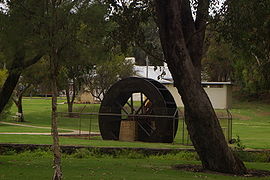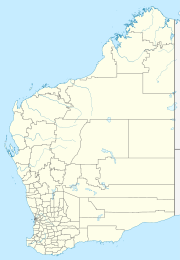Gingin, Western Australia
|
Gingin Western Australia |
|
|---|---|

Water Wheel in Gingin park, from the original flour mill in Gingin
|
|
| Coordinates | 31°20′S 115°55′E / 31.34°S 115.91°ECoordinates: 31°20′S 115°55′E / 31.34°S 115.91°E |
| Population | 531 (2006 census) |
| Postcode(s) | 6503 |
| Elevation | 96 m (315 ft) |
| Location | |
| LGA(s) | Shire of Gingin |
| State electorate(s) | Moore |
| Federal Division(s) | Pearce |
Gingin is an agricultural town in Western Australia. The town is located 92 kilometres (57 mi) north of Perth along the Brand Highway.
The town is well suited for agriculture with a mild climate and available water sources. The area supports many forms of farming including beef cattle, cereal crops, olives, oranges and mangoes.
The first European to visit the area was the explorer George Fletcher Moore; he arrived in 1836 and recorded the Aboriginal name "Jinjin" on his charts.
The first property to be established in the area by W. L. Brockman in 1841 was named Gingin station. The meaning of the word Gingin is uncertain but is thought to mean "footprint" or "place of many streams".
A townsite, Granville, was established close-by in 1839 but once Gingin was gazetted in 1871 Granville was never developed.
By 1853 an area along Gingin Brook was fenced for horses to rest on the way from Perth to Geraldton and a police station was built nearby.
Construction of the telegraph line between Gingin and Perth was completed in 1886, and the railway line was completed in 1891. Gingin was declared a town in 1883.
In 2003, plans were unveiled to construct the Gravity Discovery Centre near Gingin adjacent to the existing Australian International Gravitational Observatory. A.I.G.O. is part of a worldwide array of observatories, completing the southern arm of the array to obtain three-dimensional measurements of gravitational waves. The public arm of A.I.G.O - The Gravity Discovery Centre includes a 45 m tower that leans at an angle of 15 degrees that allows students to complete free fall experiments.
...
Wikipedia

